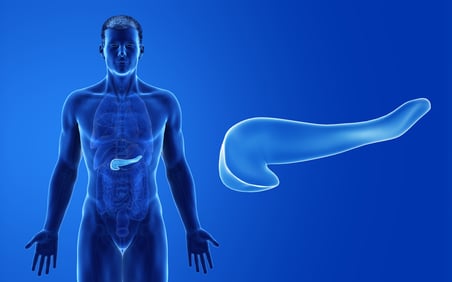Know the Signs of Pancreatic Cancer
7 min read

Author: Patrick Eulitt, MD
The early warning signs for pancreatic cancer are sometimes hard to recognize because they are the same as less serious health conditions. You might mistakenly blame a sore back, fatigue, or a little nausea on something you ate or part of growing older.
Still, when symptoms persist or worsen, it’s time to have a discussion with your healthcare provider about the possibility of pancreatic cancer. You should also have this conversation if you have had Type 2 diabetes or if you’re aware of a history of pancreatic cancer in your parents, siblings, children, or other close family members.
Why Early Detection Matters
More than 60,000 people in the United States will likely be diagnosed with pancreatic cancer in 2022. Once this type of cancer appears, it grows very slowly inside your body. A recent study suggests that pancreatic cancer can take more than a decade to cause symptoms, and by the time symptoms appear, the cancer may have already spread to other parts of the body.
The earlier pancreatic cancer is treated, the higher the survival rate. According to the American Cancer Society, if treatment begins before pancreatic cancer spreads, there is more than a 40% chance of surviving at least five years after diagnosis. However, the pancreatic cancer survival rate drops dramatically after cancer has spread to other parts of the body.
“Pancreatic cancer is challenging to detect in early stages,” said Dr. Patrick Eulitt, oncologist at Rocky Mountain Cancer Centers (RMCC). “If you notice possible symptoms, it’s essential to talk with your provider to determine the cause.”
A Quick Anatomy Review
 Before you can recognize pancreatic cancer symptoms, it’s helpful to know a little about the pancreas itself. The pancreas is an organ near your stomach containing both exocrine and endocrine cells. Exocrine cells make the enzymes your body uses to break down food in the intestines. Endocrine cells produce hormones, such as insulin, that regulate your blood sugar. Endocrine cells are grouped together in clusters that look like islands or islets.
Before you can recognize pancreatic cancer symptoms, it’s helpful to know a little about the pancreas itself. The pancreas is an organ near your stomach containing both exocrine and endocrine cells. Exocrine cells make the enzymes your body uses to break down food in the intestines. Endocrine cells produce hormones, such as insulin, that regulate your blood sugar. Endocrine cells are grouped together in clusters that look like islands or islets.
Although it’s unclear what causes pancreatic cancer, we know it can begin in either kind of cell, and the signs, symptoms, and method of treatment depends on where the cancer originates.
9 Common Symptoms of Exocrine-type Pancreatic Cancer
More than 90% of pancreatic cancer is the exocrine type. Its symptoms are generally mild and do not get worse until the cancer has grown significantly or spread to other parts of the body. Because your pancreas is behind your stomach, an additional challenge healthcare providers face is being able to see or feel a pancreatic tumor during a physical exam.
Nine common symptoms of the exocrine type of pancreatic cancer can include:
1. A History of Diabetes
“Having diabetes is a risk factor for developing pancreatic cancer,” said Dr. Eulitt. “New-onset type 2 diabetes may also be a symptom of pancreatic cancer.”
Roughly 25% of people diagnosed with pancreatic cancer are also diagnosed with Type 2 diabetes in the three years before their cancer diagnosis. People older than 50 with recent-onset diabetes are eight times more likely to have pancreatic cancer.
2. A Large Lump Under Your Ribcage
If you notice a lump form beneath the right side of your ribcage, you might have an enlarged gallbladder or liver. This could be the result of a tumor that blocks the flow of bile from those organs into your small intestine. The bile can back up in the gallbladder and make it swell. Your liver might become enlarged if the cancer has spread there. Your provider may be able to feel abnormalities during a routine exam, or he or she may order imaging tests, such as an MRI, to investigate the lumps further.
3. A Pain in Your Back
As pancreatic cancer grows, it can press against other organs or spread to nerves, causing pain in your abdomen – specifically, in the area between your belly button and your chest. You may also feel back pain from pancreatic cancer above your waist and below your shoulder blades.
4. Changes in Bowel Movements
Pancreatic cancer can sometimes cause either constipation, diarrhea, or both. You may also have bowel movements that are large, greasy, light colored, or particularly foul smelling.
5. Leg Pain and Swelling
People with pancreatic cancer have a higher risk of deep vein thrombosis (DVT), a type of clot that develops most frequently in the legs and pelvis. DVT blood clots can break loose and travel to the lungs, and when that occurs, they can be life-threatening. If your leg swells, turns red, hurts a lot, or feels warm, it could be a sign of a blood clot, and you should seek medical care immediately.
6. Nausea and Vomiting
When tumors grow and push on the stomach, they can block the movement of food through your digestive system. This can cause nausea and vomiting which is frequently associated with eating.
7. You Get Tired a Lot
If you get extremely tired, even after you have a good night’s sleep, you might be suffering from fatigue caused by pancreatic cancer. Because your pancreas makes enzymes used in breaking down food, pancreatic cancer might interfere with your digestion, keeping you from getting the energy you need. Fatigue is also a common symptom of all types of cancers.
8. You Lose Weight Without Trying
It’s normal to lose weight after you modify your diet or start to exercise – but what if you lose weight without meaning to? When combined with other symptoms, especially a history of recent-onset diabetes, unexpected weight loss can be a sign of pancreatic cancer.
9. Your Skin or Eyes Turn Yellow
Sometimes, a tumor can block the movement of bile through a duct into the small intestines. A substance called bilirubin builds up causing jaundice, one of the first typical signs of pancreatic cancer. Jaundice can also occur if the cancer spreads to your liver. Jaundice causes your skin and the whites of your eyes to turn yellow. It can also cause itchy skin and dark urine.
Symptoms of Endocrine-type Pancreatic Cancer
When you develop a tumor in endocrine cells, your pancreas can produce extra hormones that throw your body’s energy production out of balance. Pancreatic endocrine tumors are a kind of neuroendocrine tumor (NET) classified as either functioning or nonfunctioning depending on whether the tumor produces extra hormones.
When Your Pancreas Makes Too Much Insulin
The most common functioning NET is insulinoma, making up about 70% of all pancreatic endocrine-type tumors. Insulinoma produces excess insulin, which causes low blood sugar that leads to the following symptoms:
- Confusion
- Fast heartbeat
- Feeling weak
- Loss of consciousness
- Seizures
- Sweating
Other Functioning NET Symptoms
A functioning NET in your pancreas could also affect the production of hormones that regulate digestion and other bodily functions. These tumors can cause symptoms that include:
- A red rash with blisters and swelling that, over time, can appear in different parts of your body
- Abdominal pain
- Diarrhea or black, tarry stool
- Feeling extra hungry or thirsty
- Increased urination
- Jaundice
- Nausea and vomiting
- Redness or warmth in your face or neck
- Weight loss
Nonfunctioning NET Symptoms
Nonfunctioning pancreatic NETs make very few hormones and do not cause symptoms until they become large. As nonfunctioning NETs grow, symptoms are like those of exocrine pancreatic cancer. A nonfunctioning NET may turn into a functioning tumor, and patients will experience the same symptoms as a functioning tumor.
Pancreatic Cancer Surgery
 After your healthcare provider confirms that you have pancreatic cancer, you will likely be referred to an oncologist. Your treatment plan will depend on the type of pancreatic cancer you have, how big the tumor is, whether the cancer has spread to other parts of your body, and how healthy you are.
After your healthcare provider confirms that you have pancreatic cancer, you will likely be referred to an oncologist. Your treatment plan will depend on the type of pancreatic cancer you have, how big the tumor is, whether the cancer has spread to other parts of your body, and how healthy you are.
Surgery to remove the tumor is the best treatment for pancreatic cancer, but surgery may not be initially possible at time of diagnosis. If the cancer is small and hasn’t spread, your surgeon may be able to remove the tumor. If the cancer is larger, your surgeon may need to remove your pancreas and other parts of your intestines. You can live without a pancreas, but you will develop diabetes. This is because your pancreas produces the insulin that regulates your blood sugar. Without your pancreas, you will need to take insulin shots. You will also need enzyme pills to help with your digestion.
Pancreatic Cancer Treatments Beyond Surgery
If the cancer has spread, or if you aren’t able to have surgery, your oncologist may recommend other treatments to help manage your symptoms. These treatments include the following:
- Chemotherapy kills cancer cells using specialized medications. For people with pancreatic cancer, it’s typically given intravenously to deliver the medication into your bloodstream.
- Radiation therapy uses beams of high-energy rays to destroy cancer cells. Radiation can be given alone or with other treatments.
- Targeted therapy is often used with chemotherapy. This involves taking medication that slows down the growth of pancreatic cancer.
Research is also being done to develop new treatment options and is particularly important for patients with pancreatic cancer. RMCC offers clinical research trials to patients who qualify. This allows people to receive the latest and most advanced treatment options for pancreatic cancer.
If you were recently diagnosed with pancreatic cancer or would like a second opinion about your treatment options, the cancer experts at RMCC are here to offer guidance, support, and treatment. Request an appointment at the RMCC location near you.